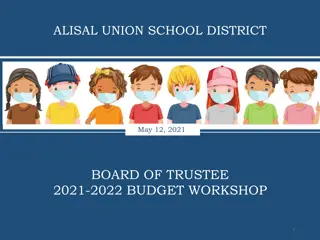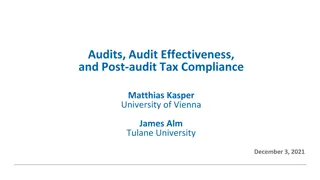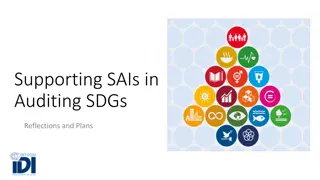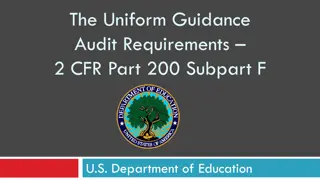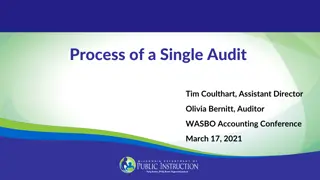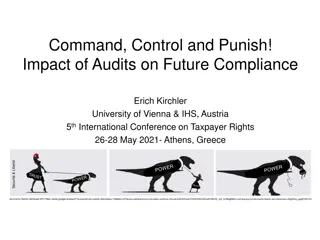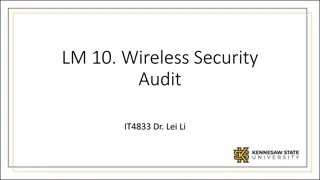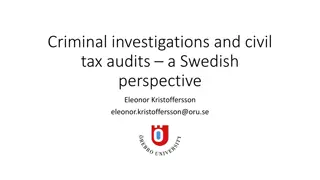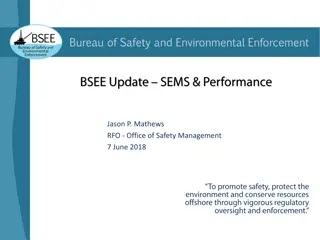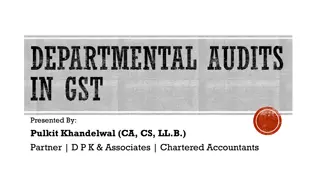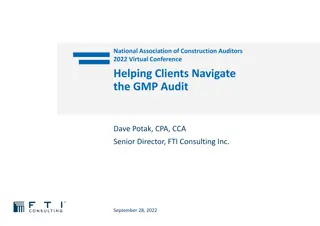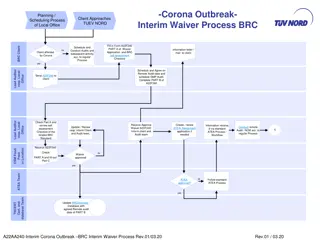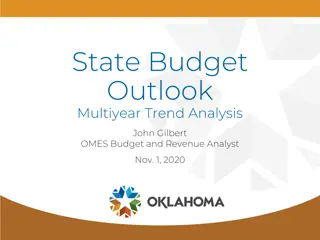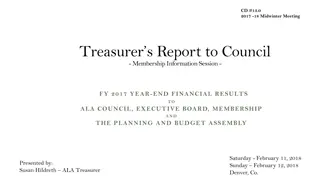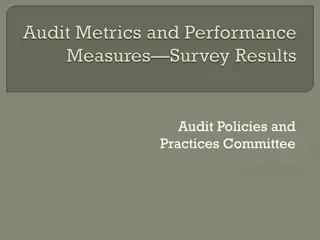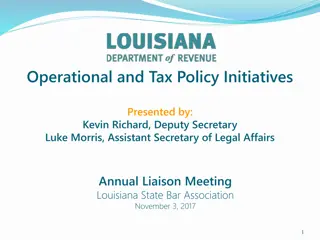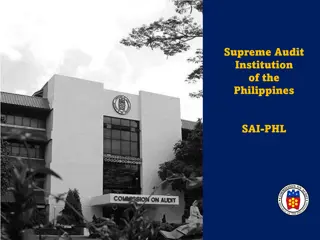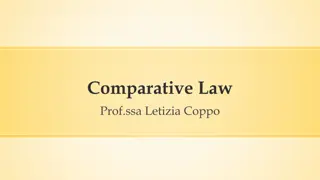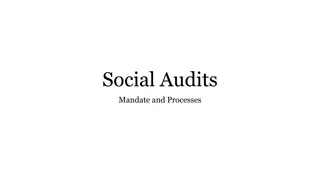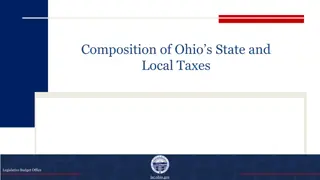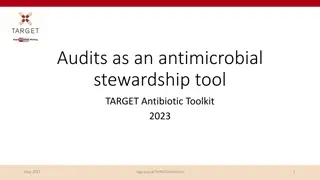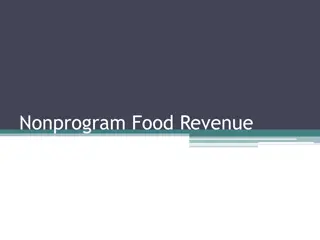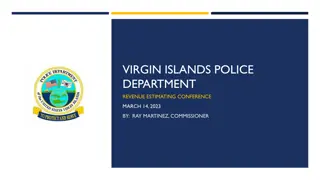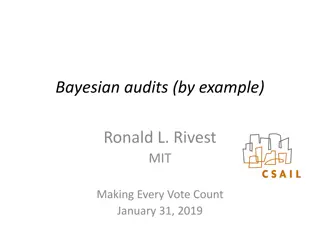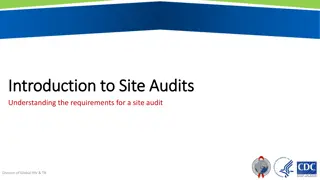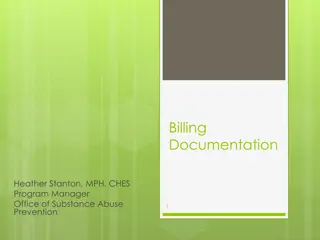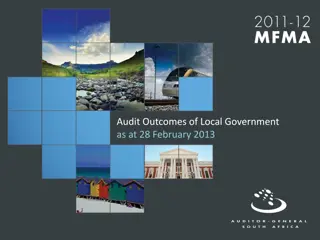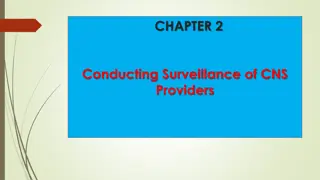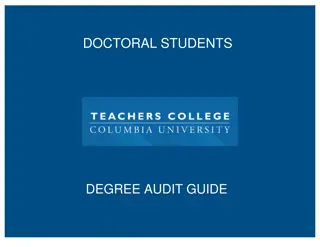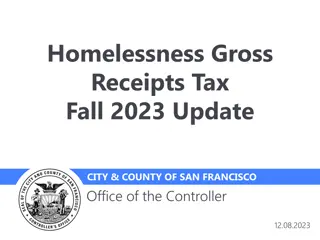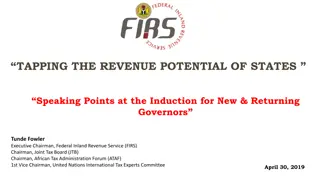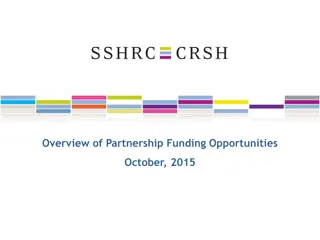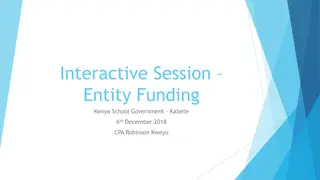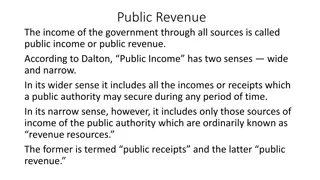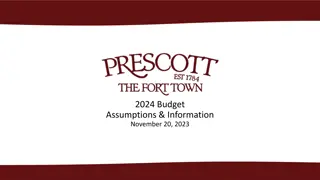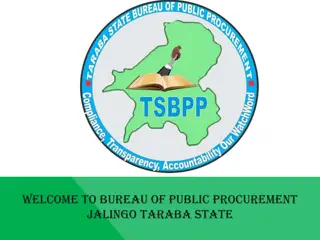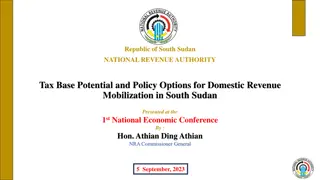Understanding Federal Partnership Audits and Their Impact on State Revenue Departments
The presentation discusses the impact of federal partnership audits on state revenue departments, emphasizing how states benefit from federal audit efforts. It covers topics such as reporting federal audit adjustments, the background of federal audit adjustments, and the final determination process. The need for uniformity in reporting federal audit adjustments to states is highlighted, along with the varying methods and timing requirements across different states.
Download Presentation

Please find below an Image/Link to download the presentation.
The content on the website is provided AS IS for your information and personal use only. It may not be sold, licensed, or shared on other websites without obtaining consent from the author. Download presentation by click this link. If you encounter any issues during the download, it is possible that the publisher has removed the file from their server.
E N D
Presentation Transcript
FEDERAL PARTNERSHIP AUDITS AND THE IMPACT ON STATE REVENUE DEPARTMENTS Presentation to the Louisiana Tax Institute Council On State Taxation & the Multistate Tax Commission October 30, 2017 1
Presenters Council on State Taxation Nikki Dobay Fred Nicely Multistate Tax Commission Helen Hecht 2
Reporting Federal Audit Adjustments: Background States use federal taxable income, and other federally determined amounts, for computing state taxable income so if a taxpayer underreports federal income, the taxpayer will also owe state tax This allows states to benefit from federal audit efforts Federal (IRS) audits can take years audits generally extend beyond normal federal and state statute of limitations IRS audit issues are often resolved at different times, with some issues creating refunds and others creating liabilities Some IRS audit adjustments have no impact at the state level (e.g., some federal credit adjustments) 3
Reporting Federal Audit Adjustments: Background Multistate Tax Commission has a Model Statute for states requiring taxpayers to report federal audit adjustments Model adopted in 2003 when all states already had some type of reporting requirement in place Model needs updating to address changes in IRC and IRS audit procedures Taxpayer groups working to inform state legislators of the need for uniformity: The time to report federal audit adjustments to states varies widely - ranges from no set date to one year 4
Reporting Federal Audit Adjustments: Background Final Determination The events triggering the reporting of federal audit adjustments vary widely Definition of final determination varies Some States require adjustments to be reported as settled serial reporting Other States only require reporting after all adjustments are final The method to report federal audit adjustments varies widely Full amended return Other state specific notice requirements (e.g., simplified amended return or other written notification) State specific spreadsheet or template 5
States That Require Filing/Payment Based on Partial Settlement No No Response Yes Depends WA ME MT ND NYC VT OR MN NH ID WI SD MA MI NY CT WY RI PA IA NV NE NJ OH MD IN DE IL UT CA WV CO DC VA KS MO KY NC TN OK AZ NM AR SC GA AL MS AK TX LA HI FL 6 Source: BBNA 2017 Survey
States That Require Filing Based on Other State and Local Tax Agency Adjustment No Response States that require filing based on other state AND local tax agency adjustment States that require filing based on other state tax agency adjustment WA ME MT ND VT OR NYC MN NH ID MA: Depends for local tax changes WI SD MA MI NY CT WY RI PA IA NV NE NJ OH MD IN DE IL UT CA WV CO VA DC KS MO KY NC TN OK AZ NM AR SC GA AL MS AK TX LA HI FL Source: BBNA 2017 Survey 7
States That Require Return & Those That Allow Writing or Imputed Filing Adequate notice of a reportable adjustment is only made when a taxpayer actually files an amended return Adequate notice of a reportable adjustment may be made when a taxpayer files some type of notice in writing to the agency Adequate notice of a reportable adjustment is only made when a taxpayer files an amended return and may be made when a taxpayer files notice in writing to the agency WA Depends ME MT ND VT OR Adequate notice of a reportable adjustment is imputed to the tax agency from the day the IRS or another jurisdiction provides information to the agency MN NYC NH MA CT ID WI SD MI NY WY RI PA IA Depends Adequate notice of a reportable adjustment may be made when a taxpayer files notice in writing and is imputed to the tax agency from the day the IRS or another jurisdiction provides information to the agency NV NE NJ OH MD IN DE IL UT CA WV CO VA DC KS MO KY NC Adequate notice of a reportable adjustment is only made when a taxpayer actually files an amended return and is imputed to the tax agency from the day the IRS or another jurisdiction provides information to the agency Adequate notice of a reportable adjustment is only made when a taxpayer files an amended return and may be made when a taxpayer files notice in writing to the agency and is imputed to the tax agency from the day the IRS or another jurisdiction provides information to the agency TN OK AZ NM AR SC GA AL MS AK TX LA HI FL 8 Source: BBNA 2017 Survey
States with Definition of a Final Determination Source: COST Administrative Scorecard, December 2016 9
Reporting Federal Audit Adjustments: Opportunities for Enhancements Uniformity alone would aid taxpayers and improve compliance 180 days allows for more accurate reporting Clear Final Determination Date that requires reporting federal tax changes once is more efficient for tax agencies and taxpayers Many federal audit adjustments are de minimis; however, most States still require full reporting Difficult for taxpayers to make estimated payments States unnecessarily wait for tax payments from taxpayers Taxpayers are subject to interest on under-remitted amounts Streamlined reporting would enable taxpayers to report adjustments more quickly and accurately 10
When Do Taxpayers Have to File Report Changes within 120 days Report Changes within 30 days Report Changes within 180 days or longer Report Changes within 60 days No statutory time limit to report federal changes Report Changes within 90 days Notes CA: Within 6 months IA: 60 days for payment, 180 days for refund NH: Within 6 months NY: 120 days for combined reports OH: No state CIT; post-TY 2015, 60 days for amended municipal income tax returns OK: Within one year OR: 60 days if Portland/Multnomah County PA: Within 6 months (Tax Years pre-2013, 30 days) VA: Within one year. No Corporate Income Tax WA ME MT ND VT OR MN NH ID WI SD MI NY M A CT WY RI PA IA NV NE NJ DE MD OH IN IL UT CA WV CO VA DC KS MO KY NC TN OK AZ NM AR SC GA AL MS AK TX LA HI FL 11 Source: COST Updated State Tax Administration Scorecard
New Federal Partnership Audit Process The Bipartisan Budget Act of 2015 made substantial changes to the federal audit process. Now, most large partnerships (with more than 100 partners or multiple tiers) will be subject to audit at the partnership level The default rule will be that the partnership pays tax on adjustments including adjustments made to allocations between partners Partnership can elect to push-out the tax due to the partners in the adjustment year (so no amended returns for the reviewed year will be filed) 12
C:\Users\HEH.MTC\AppData\Local\Microsoft\Windows\INetCache\IE\T31DWRFO\graphic_showing_a_pen_and_paper_writing_a_report_0515-0909-2722-3528_SMU[1].jpgC:\Users\HEH.MTC\AppData\Local\Microsoft\Windows\INetCache\IE\T31DWRFO\graphic_showing_a_pen_and_paper_writing_a_report_0515-0909-2722-3528_SMU[1].jpg C:\Users\HEH.MTC\AppData\Local\Microsoft\Windows\INetCache\IE\C7IYWDC3\business-man-vector[1].png C:\Users\HEH.MTC\AppData\Local\Microsoft\Windows\INetCache\IE\T31DWRFO\3842006065_aa9e505c3f[1].jpg IRS Logo C:\Users\HEH.MTC\AppData\Local\Microsoft\Windows\INetCache\IE\NHH3HCFL\feature_enterprisesocial_OfficeClipArt-600x399[1].jpg IRS Logo C:\Users\HEH.MTC\AppData\Local\Microsoft\Windows\INetCache\IE\NHH3HCFL\feature_enterprisesocial_OfficeClipArt-600x399[1].jpg Phase I Partnership Audit C:\Users\HEH.MTC\AppData\Local\Microsoft\Windows\INetCache\IE\ILIYK5CI\red-question-mark[1].png C:\Users\HEH.MTC\AppData\Local\Microsoft\Windows\INetCache\IE\T31DWRFO\3842006065_aa9e505c3f[1].jpg C:\Users\HEH.MTC\AppData\Local\Microsoft\Windows\INetCache\IE\ILIYK5CI\calendar[1].jpg C:\Users\HEH.MTC\AppData\Local\Microsoft\Windows\INetCache\IE\C7IYWDC3\Rfc1394-Notice-Blank[1].png C:\Users\HEH.MTC\AppData\Local\Microsoft\Windows\INetCache\IE\ILIYK5CI\5126490870_99e5e73ef9[1].jpg IRS Logo Proposed Partnership Adjustment C:\Users\HEH.MTC\AppData\Local\Microsoft\Windows\INetCache\IE\C7IYWDC3\USAStates[1].png Phase II Modification Period C:\Users\HEH.MTC\AppData\Local\Microsoft\Windows\INetCache\IE\ILIYK5CI\red-question-mark[1].png C:\Users\HEH.MTC\AppData\Local\Microsoft\Windows\INetCache\IE\C7IYWDC3\envelope-payment-due-notice-letter-5139935[1].jpg IRS Logo C:\Users\HEH.MTC\AppData\Local\Microsoft\Windows\INetCache\IE\NHH3HCFL\feature_enterprisesocial_OfficeClipArt-600x399[1].jpg C:\Users\HEH.MTC\AppData\Local\Microsoft\Windows\INetCache\IE\NHH3HCFL\feature_enterprisesocial_OfficeClipArt-600x399[1].jpg C:\Users\HEH.MTC\AppData\Local\Microsoft\Windows\INetCache\IE\ILIYK5CI\red-question-mark[1].png C:\Users\HEH.MTC\AppData\Local\Microsoft\Windows\INetCache\IE\C7IYWDC3\Rfc1394-Notice-Blank[1].png C:\Users\HEH.MTC\AppData\Local\Microsoft\Windows\INetCache\IE\ILIYK5CI\red-question-mark[1].png C:\Users\HEH.MTC\AppData\Local\Microsoft\Windows\INetCache\IE\ILIYK5CI\5126490870_99e5e73ef9[1].jpg C:\Users\HEH.MTC\AppData\Local\Microsoft\Windows\INetCache\IE\ILIYK5CI\law-clip-art-5[1].gif Final Partnership Adjustment C:\Users\HEH.MTC\AppData\Local\Microsoft\Windows\INetCache\IE\C7IYWDC3\business-man-vector[1].png C:\Users\HEH.MTC\AppData\Local\Microsoft\Windows\INetCache\IE\ILIYK5CI\red-question-mark[1].png Phase III Partnership Pays or Pushes Out 13
Phase I: Partnership Audit General The partnership audit may affect all partners including both direct and indirect taxpayer-partners The audit will broadly encompass all issues affected by the reporting of partnership items of income and transactions IRS audits at partnership level Large partnerships with more than 100 partners or non-taxpayer partners Small partnerships not electing out For the typical audit year ( reviewed year ) which will be 2-3 years in the past when the audit begins Every partnership must designate a partnership representative (PR) Does not need to be an individual or a partner Must be a U.S. person If the partnership does not have a qualified PR, the IRS may appoint one 14
Phase I: Partnership Audit Role of the PR is governed by federal law and the partnership agreement Under federal law PR will make binding decisions for the partners and the partnership with respect to the audit Under the partnership agreement - the partners may direct the PR s decisions but the agreement cannot conflict with the PR role under federal law General scope of the federal audit The audit will cover the partnership return (1065) and the allocation of partnership items made on the K-1s to all partners (but not allocations at upper or lower partnership tiers) The IRS will typically be auditing one year but the adjustments may affect subsequent years as well and these effects will be taken into account 15
Phase I: Partnership Audit Under proposed regulations, adjustments will be determined and imputed underpayments will be calculated as follows: Related adjustments will be grouped Adjustments within groupings will be netted Netted adjustments will form the basis for two types of imputed underpayments of concern to states General imputed underpayment (affecting all partners) of which there will be only one Specific imputed adjustments (affecting only some partners) of which there could be more than one 16
Phase I: Partnership Audit Final audit report reviewed by PR As part of the audit process, the IRS will provide the proposed adjustments to the PR and may agree to review certain information prior to the issuance of the notice of proposed partnership adjustment (PPA) in an effort to resolve issues in an expedited fashion However, once the PPA is issued, the modification procedures (discussed next) are the partnership s only formal route to request changes from the IRS to an imputed underpayment set forth in the PPA IRS will issue a notice of proposed partnership adjustment (PPA) computed, generally, as follows: Net adjustments to partnership items having a positive affect on tax due PLUS Positive re-allocations to partners (not net of negative re-allocations) TIMES Highest tax rate NOTE The partnership will also be entitled to go to Administrative Appeals before the final adjustments are made but this process and the timing are yet to be clarified. 17
Phase II: Modification Period The IRS provides a 270-day modification period Period may be extended by IRS Purpose of the period is to allow the PR to obtain all information necessary for any modifications to the PPA Partners may choose to pay up By amending their reviewed (audit) year returns, as well as subsequent returns affected by adjustments, and pay the tax on the adjustments if SOL is still open If SOL is not open A partner may extend the SOL and file an amended return A partner may enter into a closing agreement and pay, without filing an amended returns No requirement for all partners to amend BUT if there is to be a modification of the partnership liability for a re-allocation adjustment then all partners affected by that re- allocation must file It does not appear partners can challenge the adjustments if they file amended returns 18
Phase II: Modification Period State effects under existing law if amended federal returns are filed - If partners file amended federal returns state amended returns will also be required But there will not be an amended federal partnership return (1065) or an amended K-1 instead the partners would base their federal amended returns on the PPA and supporting audit adjustment information There may be no requirement to file an amended composite return BACK TO HOME PAGE 19
C:\Users\HEH.MTC\AppData\Local\Microsoft\Windows\INetCache\IE\ILIYK5CI\red-question-mark[1].pngC:\Users\HEH.MTC\AppData\Local\Microsoft\Windows\INetCache\IE\ILIYK5CI\red-question-mark[1].png Phase II: Modification Period Important issues not addressed under existing state law Amended Returns Filed What happens if a composite return was filed originally and a partner wants to amend Some partners may file amended returns reducing tax owed (for example where there are re-allocated amounts) resulting in refunds which may or may not be allowed States may also want a closing-agreement procedure, similar to the IRS IRS will modify the PPA based primarily on two kinds of information provided by the PR: Information that one or more partners have filed amended returns, taken all adjustments into account for all affected years (which may include years subsequent to the reviewed year) and have paid the tax due If the adjustments are re-allocations of partnership items, all affected partners must have filed amended returns Information on partner tax rates or tax exempt status 20
Phase III: Partnership Pays or Pushes Out The IRS will issue a modified final partnership adjustment (FPA) to the partnership The FPA is computed in a similar fashion to the proposed partnership adjustment This FPA is the partnership-level liability that would have to be paid if the partnership does not push out the adjustments to the partners\At this point, the PR has several decisions to make: Whether to pay the FPA without contesting it Whether to elect to push-out the adjustments without contesting them Whether to contest the FPA (or some part) without electing to push out adjustments Whether to contest the FPA (or some part) and push out the adjustments 21
Phase III: Partnership Pays or Pushes Out Partnership pays If the PR decides not to elect to push out the adjustments, the partnership will have to pay the FPA Practitioners and taxpayers worry that it is not clear how this tax should be viewed whether it is, in effect, tax owed by some or all of the taxable partners but paid by the partnership Partnership elects to push out adjustments If the PR elects to have the partnership push out the adjustments to the reviewed- year partners, then the partnership will have to provide the affected partners (and the IRS) information returns Containing necessary information to compute the tax for all affected years (including years subsequent to the reviewed year, if necessary) So that it can be reported and paid on their current (adjustment) year returns Partnership is then relieved of liability 22
Phase III: Partnership Pays or Pushes Out PR contests the FPA adjustments PR may contest the adjustment whether or not the push-out election is made Partnership must pay the FPA as a deposit in order to contest any adjustments, but can defer pushing out those adjustments until there is a final determination Partnership and all affected partners will be represented by the PR who will make all decisions (presumably, assisted by counsel) A final determination occurs when the matter is resolved without the option for further appeal BACK TO HOME PAGE 23
State Effects - Generally The states need to address: How to treat amended federal returns taxpayers may file during the modification period How to treat partnerships that elect to pay the tax at the federal level Whether to allow different treatment at the state level Can partnerships simply file amended returns (entity returns along with any composite or withholding returns) and K-1s for partners and have partners file amended returns for the reviewed year Other issues allocation and apportionment of federal adjustments How to collect tax owed when the liability will have occurred years earlier and the partnership may be defunct or partners may have moved from the state. 24
New Federal Partnership Audit Rules: State Implications MTC has an ongoing Partnership Project to study - Do the States need to amend their tax laws to address new partnership audit procedures? If so, how should those laws be revised? How should the States deal with multiple-tiered entities? Website: http://www.mtc.gov/Uniformity/Project-Teams/Partnership-Informational- Project Only Arizona has enacted legislation conforming to new federal legislation Arizona s legislation does not comprehensively address federal changes (e.g., fails to address tiered partnership) Five states (CA, GA, MN, MO and MT) proposed legislation this year None of the proposals took the same approach nor were as comprehensive as the Draft Model Statute 25
Draft Model Legislation 26
How Its Accomplished: Interested Parties The Organizations working on this Draft Model Statute are: ABA Section of Taxation SALT Committee Task Force American Institute of CPAs (AICPA) Council On State Taxation (COST) Institute for Professionals in Taxation (IPT) Tax Executives Institute (TEI) Multistate Tax Commission (MTC) Note: This Draft Model Statute has not yet been formally endorsed by the Interested Parties - it is a draft for discussion purposes only 27
How Its Accomplished: Draft Model Statute - Overview Section A Definitions Section B Reporting Adjustments to Federal Taxable Income General Rule Section C Reporting Adjustments to Federal Taxable Income Partnership Level Audits Section D Assessments of Additional [State] Tax, Interest, and Penalties Arising from Adjustments to Federal Taxable Income Section E Estimated [State] Tax Payments During the Course of a Federal Audit Section F Claims for Refund or Credits of [State] Tax Arising from Federal Adjustments Made by the IRS Section G Scope of Adjustments and Extensions of Time Section H Effective Date 28
How Its Accomplished: Important Definitions Federal Adjustments Report (FAR) An amended State tax return, The Multistate Tax Commission s model report of federal audit adjustments, or Any other method or form authorized by the State agency Final Determination Date - Date on which all adjustments made by the IRS to the federal taxable income of a taxpayer for the taxable year have become final and all appeal rights under the IRC are exhausted or waived Streamline reporting by creating one final determination date for each tax year under audit, which eliminates the requirement to file multiple amended returns 29
How Its Accomplished: Optional Final Determination Date Regulation States have the option to have a more expansive Final Determination Date definition that can be put in the State s law or placed in a regulation More detailed description of what constitutes a Final Determination date along with and cites to IRC provisions Examples of Final Determination Dates are also provided 30
How Its Accomplished: General Reporting Process Reporting Adjustments to Federal Taxable Income General Rule (this does not apply to a Partnership (and their partners) subject to a Partnership Level Audit) Taxpayer shall notify the State agency of adjustments to its federal taxable income within 180 days of the Final Determination Date or amended federal return Includes an optional de minimis ($250) provision to notify State of change without filing Federal Adjustments Report Note: De minimis provisions will not apply to partnerships subject to a partnership level audit or their partners 31
Flow Chart Following Reporting Federal Audit Adjustment (This is not for Partnerships subject to Partnership Level Audit) Taxpayer does not appeal IRS Issues Notice of Determination 90 days Taxpayer appeals File Federal Adjustments Report Final Determination Date 180 Days Final Court Decision (appeal rights expired) 32
How Its Accomplished: Partnership Definitions Partnership Definitions: State Imputed Underpayment The total net under-paid tax based on a state s tax rate and that state s apportioned share of the partnership s under-reported income State Partnership Adjustment Report Form prescribed by the State that conforms with the IRS form to identify all of a partnership s partners and their allocable share of any federal audit adjustments Partnership Level Audit BBA audit (IRC Section 6221(b)) Resident Partner An individual, estate of a deceased individual, or trust that was a partner and a resident of the State for income tax purposes State Partnership Representative Federal partnership representative or the person designated to be the partnership s representative for state tax purposes 33
How Its Accomplished: Reporting Federal Partnership Level Audits If a Federal Partnership Level Audit results in a State Imputed Underpayment to State, the partnership shall within 60 days of the Partnership s Final Determination Date: File a Federal Adjustments Report with the State to notify the State of the partnership s taxable income apportioned to State AND Make an election as to whether the partnership or its partners will pay the tax: Option 1: Partnership pays the tax (entity level tax) for ALL partners Option 2: Partnership pays the tax on behalf of composite* return partners and all other Partners pay the tax (partnership issues Amended State Schedule K-1 ) Option 3: Hybrid approach, partnership pays the tax on behalf of all composite return AND non-resident partners but only resident partners pay their own tax (partnership issues Amended State Schedule K-1 ) Election is irrevocable unless the State, in its discretion, otherwise allows *For purposes of this discussion, composite return includes both a state s required composite and/or withholding tax regimes 34
How Its Accomplished: Composite/Withholding Return Partners Most States have composite return filing requirement for certain partners that elect not to file separate tax returns to a State to report their income from a partnership or non-resident partners not agreeing to be subject to the State s tax on its apportioned income from the partnership The Proposed Model includes provisions to require composite return filers on an original return (or an amended return) to have the tax paid by the partnership i.e., there is no election for composite return filers to directly report and pay the tax 35
Composite Returns for Individuals Not Permitted Optional Required Under Certain Circumstances WA ME MT ND VT OR MN NH ID WI SD MA MI NY CT WY RI PA IA NV NE NJ OH MD IN DE IL UT CA WV CO Entity Tax VA DC KS MO KY NC TN OK AZ NM AR SC GA AL MS AK TX LA HI Source: Bloomberg BNA and RIA Charts FL 36
Composite Returns for Corporations Not Permitted Required* Optional WA ME MT ND VT OR MN NH ID WI SD MA MI NY CT WY RI PA IA NV NE NJ OH MD IN DE IL UT CA WV CO Entity Tax VA DC KS MO KY NC TN OK AZ NM AR SC GA AL MS AK TX LA HI Source: Bloomberg BNA and RIA Charts FL 37 *Required returns may be limited to certain circumstances
Withholding for Individuals Not Required Required* Optional WA ME MT ND VT OR MN NH ID WI SD MA MI NY CT WY RI PA IA NV NE NJ OH MD IN DE IL UT CA WV CO VA DC KS MO KY NC TN OK AZ NM AR SC GA AL MS AK TX LA HI Source: Bloomberg BNA and RIA Charts FL 38 *Required withholding may be limited to certain circumstances
Not Required Required* Not Permitted WA ME MT ND VT OR MN NH ID WI SD MA MI NY CT WY RI PA IA NV NE NJ OH MD IN DE IL UT CA WV CO Entity Tax VA DC KS MO KY NC TN OK AZ NM AR SC GA AL MS AK TX LA HI Source: Bloomberg BNA and RIA Charts FL *Required withholding may be limited to certain circumstances 39
How Its Accomplished: Reporting Federal Partnership Level Audits Federal Partnership Representative acts on behalf of the partnership unless the Federal Partnership Representative delegates such authority to another person Model Requires partners to file and pay if: The federal audit results in a reallocation of income from specific partner(s) to another partner The federal audit does not result in an Imputed Underpayment to the State; or The partnership has dissolved or becomes insolvent The partnership fails to pay after one year The States tax agencies can promulgate regulations to address special allocations among or between the partners that are affected by a BBA audit 40
How Its Accomplished: Reporting Federal Partnership Level Audits Option 1 Partnership Pays the Tax Within 180 days of Final Determination Date, the partnership shall: File a schedule indicating each partner s apportioned share of under-reported state taxable income with the State, and Calculate and pay the additional state tax owed by the partnership Calculation of Partnership s Tax Option 1: Tax-exempt or nontaxable partners - zero percent tax rate Individual partners, S corporations, trusts, estates of deceased partners, disregarded entities that are not owned by a C corporation, or entities treated as partnerships for state tax purposes - highest state individual income tax rate, and C corporations, disregarded entities owned by C corporations, and Unrelated Business Taxable Income of tax-exempt or nontaxable partners - highest state corporate income tax rate 41
How Its Accomplished: Reporting Federal Partnership Level Audits Option 2 Partners Pays the Tax Within 90 days of Final Determination Date, the partnership shall: Mail Amended State Schedule K-1s to each partner with a copy to the state Within 180 days of Final Determination Date, the partners shall: File a State Partnership Adjustment Report with State indicating each partner s apportioned share of under-reported state taxable income with State, and Calculate and pay the additional state tax owed by the composite return partners Within 180 days of Final Determination Date, all other partners shall file a Federal Adjustments Report with State and pay any additional tax due 42
How Its Accomplished: Reporting Federal Partnership Level Audits Option 3 Hybrid Method Within 90 days of Final Determination Date, the partnership shall: Mail Amended State Schedule K-1s to each partner with a copy to the state, and Within 180 days of Final Determination Date, the partnership shall: File a State Partnership Adjustment Report with State indicating each partner s apportioned share of under-reported state taxable income with State, and Calculate and pay the additional state tax owed by the composite return and non- resident partners Within 180 days of Final Determination Date, all resident partners shall file a Federal Adjustments Report with State and pay any additional tax due 43
Flow Chart following Federal Partnership Audit Adjustment Slide 1 Partnership does not appeal IRS Issues Notice of Final Partnership Adjustment (FPA) 90 days File Federal Adjustments Report & Makes Election Partnership appeals Final Determination Date 60 Days Go to 1, 2 or 3 on next slide Final Court Decision (appeal rights expired) 44
Flow Chart following Federal Partnership Audit Adjustment Slide 2 From previous slide Option 1 Elect to pay for all partners File schedule & Pay Tax to State 120 days Partners File Federal Adjustments Report & Pay Tax to State Option 2 Elect to push out to all partners* Mail Amended Schedule K-1s to partners & State 90 Days 30 days Option 3 For Resident partners, use 2, for other partners, use 1 Elect to push out for Resident partners, pay for others * For Composite Return Partners, Option 1 is used 45
How Its Accomplished: Tiered Partnerships Filing Requirements Tiered Partnerships are required to comply with special provisions that conforms to anticipated IRC provisions for such partnerships Have partnerships with different fiscal year ends still must file all returns by the extended federal due date of the audited partnership s return of the year the IRS completes the Final Determination Date Eliminates huge time lag that could exist if there was not a set date for all tiers to have to remit the additional tax to a State 46
How Its Accomplished: Tiered Partnerships Filing Requirements Example: ABC Partnership s 2018 Form 1065, filed in March 2019, is audited by IRS In January 2020, IRS begins an audit of ABC Partnership On August 2, 2021, IRS completes audit of ABC Partnership (issues Notice of Final Partnership Adjustment), which results in an Imputed Underpayment at the federal level (with corresponding Imputed Underpayment at State X) ABC Partnership does not appeal the Imputed Underpayment at the federal level Final Determination Date is 90 days after appeal right is exhausted October 31, 2021 ABC Partnership elects Option 2 (Amended State Schedule K-1s sent to partners) within 90 days of the Final Determination Date (January 29, 2022) Partners that are partnerships, through all tiers, must have the tax paid to State X by Sept. 15, 2022 This is the extended due date of ABC Partnership s federal tax return 47
Other Misc. Model Provisions: Assessments Assessments of Additional State Tax, Interest, and Penalties Arising from an Adjustments to Federal Taxable Income An assessment must be issued within the later of one year or the expiration of the general limitations period where a taxpayer timely files a Federal Adjustments Report Otherwise the following statutes apply: The expiration of the general limitations period One year following the date the Federal Adjustments Report was filed One year following the date on which the IRS, another State, or an organization representing and/or conducting audits for two or more States tax agencies, notified the State, in writing or by electronic means, of the federal adjustment Six years following the Final Determination Date absent fraud 48
Other Misc. Model Provisions: Estimated Payments Estimated Payments - taxpayers should be allowed to make an estimated payments to a State during a pending IRS audit State obtains tax faster Stops the running of interest to the taxpayer Does not require filing of any type of pro-forma amended return for a taxpayer to make an estimated payment Some work may be needed with some of the Integrated Tax System Providers used by the States 49
Other Misc. Model Provisions Model Statute: Clarifies the period in which a taxpayer may file a claim for refund and that a taxpayer s Federal Adjustment Report will serve as a claim for refund Provides that state adjustments shall be limited to the adjustments made by the IRS, unless a taxpayer and state taxing agency otherwise agree in writing Allows taxpayers and the state agency to agree in writing to an extend the statute beyond periods otherwise provided Specifies that the States should provide a clear effective date when the changes apply 50


